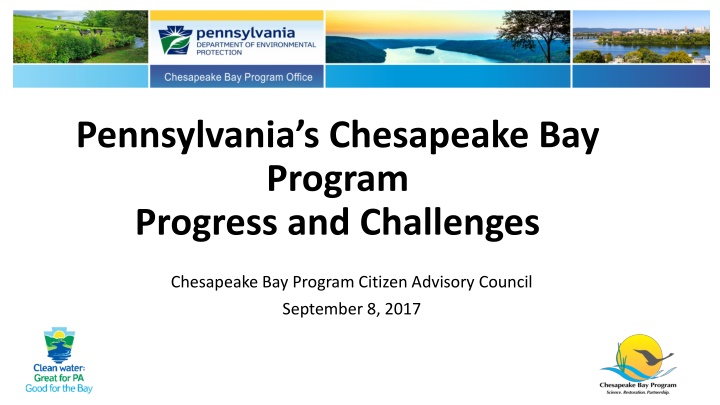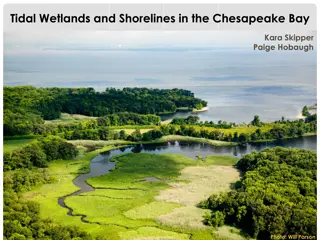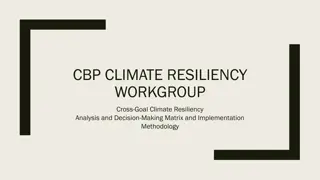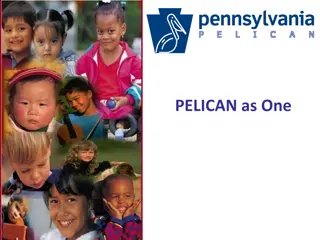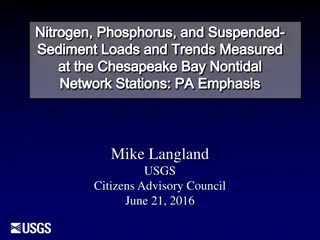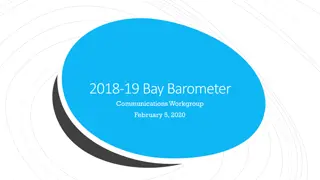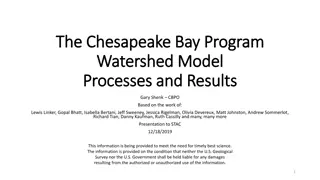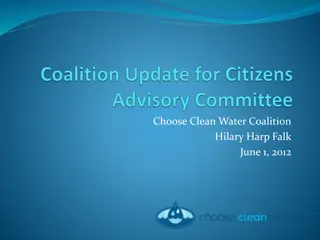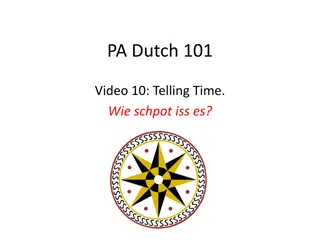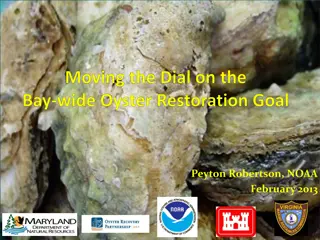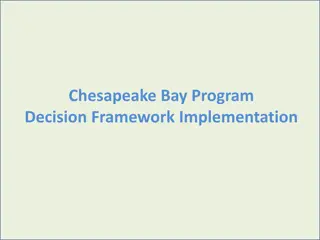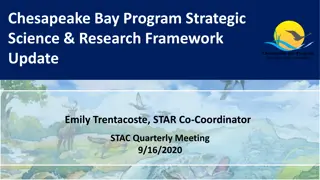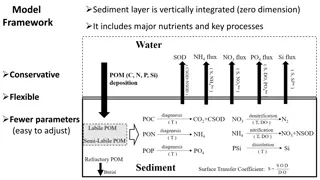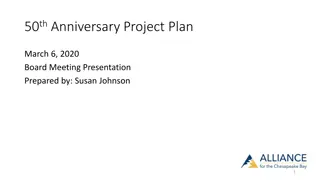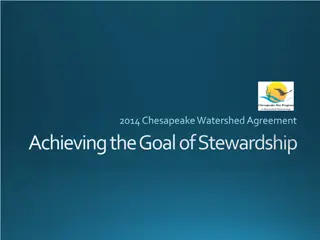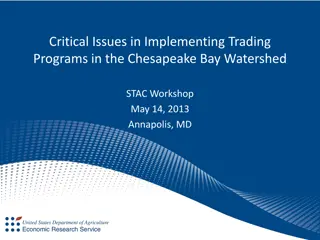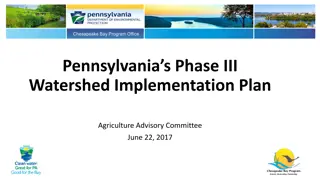Pennsylvania's Chesapeake Bay Program Progress and Challenges
Pennsylvania's Chesapeake Bay Program Citizen Advisory Council met on September 8, 2017, to discuss progress made, challenges faced, and strategies for restoration. The council highlighted the need for nitrogen, phosphorus, and sediment load reductions by 2025, focusing on agriculture as a key sector responsible for achieving these goals. The agenda included topics such as EPA expectations, funding plans, and sector-specific challenges. The state's restoration strategy aims to address urban runoff, wastewater management, and forest conservation to improve water quality. Technical assistance and cost-sharing initiatives will play a crucial role in meeting reduction targets.
Download Presentation

Please find below an Image/Link to download the presentation.
The content on the website is provided AS IS for your information and personal use only. It may not be sold, licensed, or shared on other websites without obtaining consent from the author.If you encounter any issues during the download, it is possible that the publisher has removed the file from their server.
You are allowed to download the files provided on this website for personal or commercial use, subject to the condition that they are used lawfully. All files are the property of their respective owners.
The content on the website is provided AS IS for your information and personal use only. It may not be sold, licensed, or shared on other websites without obtaining consent from the author.
E N D
Presentation Transcript
Pennsylvanias Chesapeake Bay Program Progress and Challenges Chesapeake Bay Program Citizen Advisory Council September 8, 2017
Agenda Progress Made and the Job Ahead of Us Challenges Pennsylvania s Restoration Strategy EPA Pennsylvania Specific Expectations Phase 3 WIP Game Plan Funding
Pennsylvania Nitrogen Loads: 2015 Pennsylvania Nitrogen Loads: 2015- -2025 Agriculture Urban Runoff 113 M lbs. (11 M lbs. reduced 1985-2015) 2025 Septic Wastewater+CSO Forest+ 79 M lbs. (34 M lbs. to reduce 2015-2025) 15% 1% 45% 28% Where Where will remaining Nitrogen remaining Nitrogen reductions* come from? reductions* come from? *Based on jurisdictions Phase II WIPs *Based on jurisdictions Phase II WIPs will the the 78% Agriculture 78% Agriculture 20% Urban 20% Urban 2% Septic 2% Septic 11% 2015 2025
Pennsylvania Phosphorus Loads: 2015 Pennsylvania Phosphorus Loads: 2015- -2025 2025 Agriculture Urban Runoff Wastewater+CSO Forest+ 4.3 M lbs. (1.7 M lbs. reduced 1985-2015) 3.6 M lbs. (0.7 M lbs. to reduce 2015-2025) 15% 1% 45% 28% Where Where will remaining Phosphorus remaining Phosphorus reductions* come from? reductions* come from? *Based on jurisdictions Phase II WIPs *Based on jurisdictions Phase II WIPs will the the 76% Agriculture 76% Agriculture 24% Urban 24% Urban 11% 2015 2025
Pennsylvania Sediment Loads: 2015 Pennsylvania Sediment Loads: 2015- -2025 2025 Agriculture Urban Runoff Wastewater+CSO Forest+ 2,477 M lbs. (540 M lbs. reduced 1985-2015) 1,946 M lbs. (531 M lbs. to reduce 2015-2025) 15% 1% 45% 28% Where Where will remaining Sediment remaining Sediment reductions* come from? reductions* come from? *Based on jurisdictions Phase II WIPs *Based on jurisdictions Phase II WIPs will the the 70% Agriculture 70% Agriculture 30% Urban 30% Urban 11% 2015 2025
Pennsylvanias Source Sector Challenges Needs to reduce 19 million lbs. nitrogen by 2017 and a total of 34 million lbs. by 2025 Responsible for 69 percent of remaining basinwide nitrogen load reductions by 2025 Agriculture will likely be responsible for more than 80 percent of these nitrogen reductions by 2025 How do we put the technical assistance/compliance infrastructure and cost share funding in place to deliver on these needed reductions
Restoration Strategy: Six Elements Strategy is a mix of technical and financial assistance, technology, expanded data gathering, improved program coordination and, only when necessary, stronger enforcement and compliance measures. 1) Address Pollutant Reduction 2) Quantify & Multiply BMPs 3) Improve Record-keeping 4) Identify Needed Changes 5) Seek New Resources 6) Establish a DEP Chesapeake Bay Office 7
Agricultural Inspection Initiative DEP began inspections August 29, 2016 Districts began inspections October 3, 2016 Successfully completed the first year Over 2080 Inspections Completed Over 1572 by Conservation Districts Over 508 by DEP Results of inspections to date Total Acres Covered 245,664 acres Does not include existing Act 38 Inspection Program
50 50 38 50 25 50 50 50 38 38 50 50 63 50 88 50 50 25 50 50 50 300 100 75 75 50
Data Management Initiatives Penn State Farmer Self-Reporting Survey Results (6700 surveys returned!) 475,800 acres of nutrient/manure management; 97,562 acres of enhanced nutrient management; 2,164 animal-waste storage units; 2,106 barnyard runoff-control systems; 55,073 acres of agricultural erosion and sedimentation control plans; 228,264 acres of conservation plans; More than 1.3 million linear feet of stream-bank fencing; 1,757 acres of grass riparian buffers; and 5,808 acres of forested riparian buffers. Total estimated reductions: Nitrogen -- 1,047,704 lbs/year Phosphorus -- 79,620 lbs/year Sediment -- 10,395,906 lbs/year NRCS Potomac Watershed Remote Sensing Project Collected data on 26 conservation BMPs using a grid approach Field verification spot checks were done by experienced NRCS staff using the standard USDA NRCS 5% quality assurance/quality control sample
Data Management Initiatives Worldview Development Used the existing database design that was created for five Pennsylvania county conservation districts and Virginia Department of Environmental Quality Submitted 2016 Progress Data Using the new Database Software PracticeKeeper Software Launch to ALL Districts in July, 2017 6 Modules Nutrient Management, E & S Planning, Watershed Projects, Complaints and BMPs DEP staff and 9 Districts pilot testing starting now Hardware for PracticeKeeper Funding Distributed for tablets for in-the-field data collection
Urban Stormwater Cost Share Program Municipalities, MS4 Communities in Blair, Cumberland, Dauphin, Franklin, Lackawanna, Lancaster, Lebanon, Luzerne, Lycoming and York Counties $200,000 maximum per grantee Round #1 (Awarded July, 2016) Over $2.2 million awarded to 19 projects Round #2 (Announced June 29,2016) Awarded $2.2 million for 17 projects: Stream Restoration and Buffers, Retention Basin Retrofits and Bio-retention Basins, Rain Gardens, Permeable Pavement Estimated reduction of 2,800 pounds of nitrogen, 396 pounds of phosphorus and 798,500 pounds of sediment
Agriculture BMP Special Projects Support Implementation of the Restoration Strategy BMP Implementation Projects in areas identified as part of the Agricultural Inspection Strategies In impaired watersheds or priority watersheds identified by the County in their Implementation Plans BMP verification and tracking, including the further documentation of voluntary practices Awarded $2.9 million to conservation districts for 46 projects (2 years funding) Streambank fencing and crossings, barnyard runoff controls and heavy use area protection, manure storage, rotational grazing, cover crops and no-till planting promotion Estimated reduction of 84,000 pounds of nitrogen, 2400 pounds of phosphorus, and 3.5 million pounds of sediment Extending completion date to September 30, 2019.
Funding EPA Federal Funding (Approximately $40 million per year) State Revolving Loan Fund (Wastewater Infrastructure and Nonpoint Source Projects) Section 106 Water Pollution Control (Permitting, Monitoring and Assessment, Compliance and Enforcement) Section 319 Nonpoint Source Program (Technical Assistance, Project Implementation) Chesapeake Bay Regulatory and Accountability Grant and Chesapeake Bay Implementation Grant (Program Administration, Technical Assistance, Project Implementation) State Funding (Approximately $75 million per year) DEP (Match to Federal Money above, Growing Greener) State Conservation Commission Pennvest (Wastewater Infrastructure and Nonpoint Source Projects) DCNR (Land Conservation, Riparian Buffers) Projected to Need Another $80-$100+ million per year in Cost Share to Meet Target Reduction Goals
Unliquidated Obligations (ULOs) PA EPA Grants RUMOR Pennsylvania has large amounts of unspent money In reality, every penny is accounted for EPA tracks money only as it is spent They don t count monies allocated to: Personnel (including salaries, benefits and indirects) Contract and sub-award grant commitments Conservation districts for ag inspections, technical assistance Outreach and Education BMP Installation BMP Verification, Data Management, Verification
Phase 3 Watershed Implementation Plan (WIP) Stakeholder Input and Outreach Steering Committee/Workgroups Website: www.dep.pa.gov/chesapeakebay/phase3 Communications Strategy: Builds on One-Day Kick-Off Conference, Listening Sessions, Public Comment Planning Targets & Implementation Sector Specific Local Area Goals Priority Areas/Watersheds Measurable Outputs, Milestones Emphasis on Local Water Quality, Local Goals, Local Benefits
Agriculture Workgroup Co-chairs: Matt Royer, Penn State and Lead, PA in the Balance Initiative Greg Hostetter, Deputy Secretary, Pennsylvania Department of Agriculture Doug Goodlander, Program Manager, Department of Environmental Protection John Bell, Government Relations, Pennsylvania Farm Bureau Members: Karl Brown, SCC Bill Chain, CBF Andrew Flinchbaugh, Producer David Graybill, Producer James Harbach, Producer Jeff Hill, Lancaster Conservation District James Junkin, Producer Jennifer Reed-Harry, PennAg Jennifer Schuler, Bell and Evans Chris Sigmund, TeamAg James Van Blarcom, Producer Coordinator: Jill Whitcomb
Phase 3 WIP Schedule April, May, 2017 Form Steering Committee and Workgroups June 5, 2017 Phase 3 WIP Kick-Off Conference, Radisson Harrisburg June 3 July 7, 2017 Follow-up Written Comment Response to Conference July 2017 through October 2017 Bay Program Partnership Works Through Issues Workgroups Formed, Convened Comments Compiled, Additional Information and Data Compiled October 2017 through May 2018 Workgroups and Steering Committee develop the WIP Additional Outreach Around Development of Local Planning Goals/Sector Specific Plans August/September 2018 Public Comment Period of Draft Phase 3 WIP December 2018 Submit to EPA for Partnership Review January 2019 Revise in Response to Partnership Review March 2019 Submit Final Phase 3 WIP
Local Planning Goals Jurisdictional Boundaries (County, Township, Borough, Conservation District) Federal or State Facilities Regional Entity Boundaries (River Basin Commission, Planning Commission) Watershed or sub-watershed Segment-shed as defined in the TMDL Area with a defined need for pollutant reduction (ex. MS4s) Targeted area with high pollutant loadings
EPA Pennsylvania Expectations EPA Pennsylvania Expectations Programmatic, policy, legislative and regulatory changes needed Demonstration of the staff, partnerships and financial resources needed A dedicated and targeted annual state cost-share program Next steps as we move forward: Evaluate the expectations and define how the Commonwealth can meet these expectations or Define a viable alternative to their expectations that achieves the same end result. EPA Actions Continue to target federal compliance and enforcement actions Direct or withhold federal funding Establish finer scale load allocations through a Pennsylvania-specific amendment to the TMDL Require additional reductions from point sources Promulgate nitrogen and phosphorus numeric water quality standards for Pennsylvania streams and rivers
PA in the Balance Themes around A Culture of Stewardship Four Priority Initiatives Conservation Training Soil and Stream Health Ag Certification Priority Watersheds Integral Part of the Phase 3 WIP
Public Comment 240+ Attendees at Kick-Off Listening Session: Academia 17 (+4 Facilitators from University of Virginia) Environmental Groups 32 Federal and State Legislative Offices 5 Individuals 1 Industry Associations: Agriculture 7 Local Government, Redevelopment Authorities, Water Planning -- 9 Conservation Districts 17 Government: Local 37 County 11 State -- 43 Federal -- 14 Law Firms, Private Consultants, Engineering and Private Industry -- 41 Reporters, Media -- 4 Have Final Draft of Summary Report Received Comments from 16 People through eComment and 40 through Facebook
Public Comment -- Future Input on 33 Different Topics from the Kickoff Session Alone Working Through All Comments Now with Workgroups Incorporation into the Phase 3 WIP Sector Specific Sections Incorporation into Local Planning Goals, Priority Areas or Practices Common Themes that Should be Examined Further Across Multiple Workgroups or with the Steering Committee Future Engagement, Local Focus What Should That Look Like? Additional Partners through Workgroup Members Workshops, Focus Sessions Industry Conference Presentations Additional Written Comment Periods Other
Other Resources Chesapeake Bay Program Website http://www.chesapeakebay.net Chesapeake Bay Assessment Scenario Tool - CAST http://www.casttool.org County level scenario calculator Chesapeake Bay Facility Assessment Scenario Tool - BayFAST http://www.bayfast.org Facility level scenario calculator Phase 6 Model Data Visualization Tool New Beta 4 Run https://mpa.chesapeakebay.net/Phase6DataVisualization.html
Contact Information: Katie Hetherington Cunfer khethering@pa.gov DEP Chesapeake Bay Program Website: http://www.dep.pa.gov/ChesapeakeBay Phase 3 WIP Website: www.dep.pa.gov/chesapeakebay/phase3 Veronica Kasi vbkasi@pa.gov 717-772-4053
